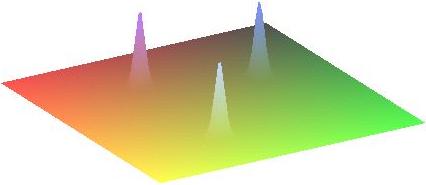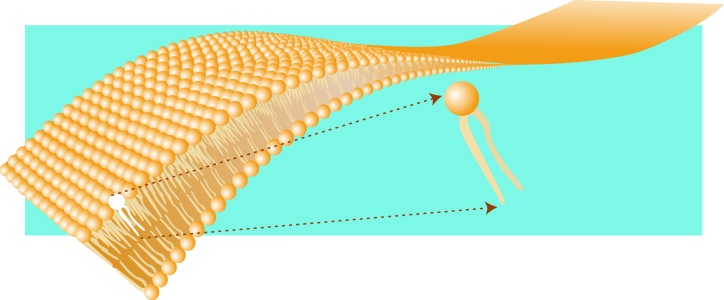 non-localized |
 localized into spike-layer solutions |
[ TU/e -> CASA -> Mark Peletier -> Partial Localization ]
Collaborators:
Yves van Gennip
Felix Otto
Matthias Röger
Marco Veneroni
To explain partial localization we first need to explain localization.
Localization of deformation is a common phenemenon in large or long elastic structures, in which deformation in a buckled structure does not extend throughout the structure, but remains confined to a small part of it. This is explained in more detail in a different page. Similarly, solutions of reaction-diffusion equations may also show localization into what are called spike-layer solutions: such solutions only take non-trivial values in the neighbourhood of a small number of points:
 non-localized |
 localized into spike-layer solutions |
Partially localized ‘structures’ are solutions of some kind of equation (to be detailed later) that are thin, localized, in some directions, and large, non-localized, in others. Doelman & Van der Ploeg showed that a Gierer-Meinhardt system has solutions in two dimensions that are stable and only depend on one variable; they look like

localized in one direction, not in the other: partially localized
This phenomenon takes an interesting turn in the context of variationally-defined systems, systems that are characterized by an energy functional. This is an important class; the membranes that separate the different parts of our body's cells are examples of such systems, and their structural and mechanical properties have been studied already in the 70's, starting with the work of Helfrich.

Lipid bilayers show a surprising feature: although at a microscopic scale they consist of molecules without covalent bonding, they show at a macroscopic scale a behaviour similar to that of elastic membranes. While Helfrich postulated this behaviour up-front, in the form of a surface density of elastic energy, it is one of our main interests to understand how this connection between low-level uncoupling and high-level coupling is achieved.
It would be nice to relate an energy-based description of lipid bilayers to the simple surface energy density of Helfrich. Since no useful microscopic description of lipid bilayers is available - because for systems of this type a faithful continuum description is not possible - we make do with a crude approximation, which shows the main features without being too complicated for analysis.
In these two papers and conference proceedings we study a singular limit process for a specific energy functional,

where d1 is the Monge-Kantorovich transport distance and the admissible set is given by

In the first two papers we cover the two-dimensional situation; 'surfaces' are actually curves. In the paper we show that in the limit of small epsilon the support of u and v resembles thin closed curves, of fixed length, and that the Gamma-limit of this energy is exactly the Helfrich surface energy functional.
This result is interesting for various reasons. First, it shows rigorously that partial localization happens in such a relatively simple system; secondly, it shows that indeed the Helfrich surface energy is the limiting energy, and therefore observed structures will be those that have 'moderate' values of this limiting energy. Finally, the main tool is an explicit and sharp lower bound for this energy that may allow us to derive many more properties.
In the third paper, we extend part of the analysis to the three-dimensional case. The upper and lower bounds are very similar, with the necessary generalizations; indeed the limiting energy is of the Helfrich type, a second-order positive quadratic form on the curvatures. The compactness question is much harder in higher dimensions, and we do not touch that one in this paper.
In this paper we study a variation of the energy above, which has received some attention in the block copolymer community:

with admissible set

The only difference lies in the distance term: instead of the Wasserstein distance we take an H-1 distance. Here we take epsilon constant, for the moment, and study various properties of this energy. In one dimension we give a full characterization of all global minimizers, and in higher dimensions we derive upper and lower bounds on the energy in the limit of large mass.
In this paper we continue the study of the functional F1 above, and focus this time on the stability of monolayers and bilayers. It turns out that monolayers are always unstable to fluctuations (undulations) of the interfaces; but bilayers can be stable, provided the interface penalization parameters satisfy a certain condition.
In this paper we make a shift to a different functional: instead of studying general sets without any restrictions on the geometry, we consider tubular neighbourhoods of curves. In the limit of thin neighbourhoods (where the thickness epsilon tends to zero) we obtain two results: (a) for a fixed curve the asymptotic development of the functional in terms of epsilon, with coefficients depending on the curvature and the number of end points; and (b) when the curve is allowed to vary as epsilon tends to zero, we prove a Gamma-convergence result for closed curves, again with a limiting functional depending on the curvature.
Last modified on January 6, 2015 by Mark Peletier